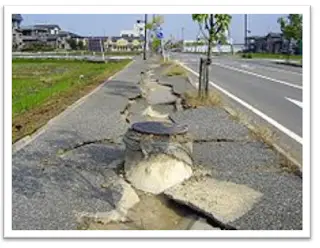When water-saturated, mostly cohesion-less soil whose shear strength is reduced to zero due to pore water pressure produced by vibration during an earthquake causes soil to soil boil and such soil is liquefied.
For more information about Soil Liquefaction see original article about Soil Liquefaction.
The drastic and sever damaging effects of soil liquefaction will cause destruction which is unavoidable and is inevitable.
 |
| Liquefaction allowed this sewer to float upward – 2004 chuetsu earthquake |
– Foundation
The buildings and structures whose foundations are on soil affected by liquefaction will experience a sudden loss of support which will result in drastic and irregular settlement of the building causing cracking of foundations and damage to the building structure itself.
If the foundation of a building have a small layer of liquefied soil underneath than such a foundation will face punching shear type failure.
– Bridges and Pile Foundations
If the structure or a bridge pier supported on pile is subjected to liquefaction as a result of earthquake than either the pile foundation will buckle or it will slightly tilt after shaking due to earthquake.
– Sloping Grounds
Slopes and grounds that are near a river or a lake may slide after liquefaction as already explained as flow liquefaction causing cracks in ground and damage to the adjacent structures.
Like Us on Facebook!
– Utility Services
Bridges, roads and other utility services like that of power, telecommunication, sewerage and natural gas will be damaged poorly due to failure as a result of liquefaction. The manholes may rise up due to buyout force caused by water in liquefaction.
Subscribe Us on YouTube!
– Earth Embankments
Earth embankments, dams and other earth retaining structures after liquefaction will collapse or become unstable making it unusable and impractical.















